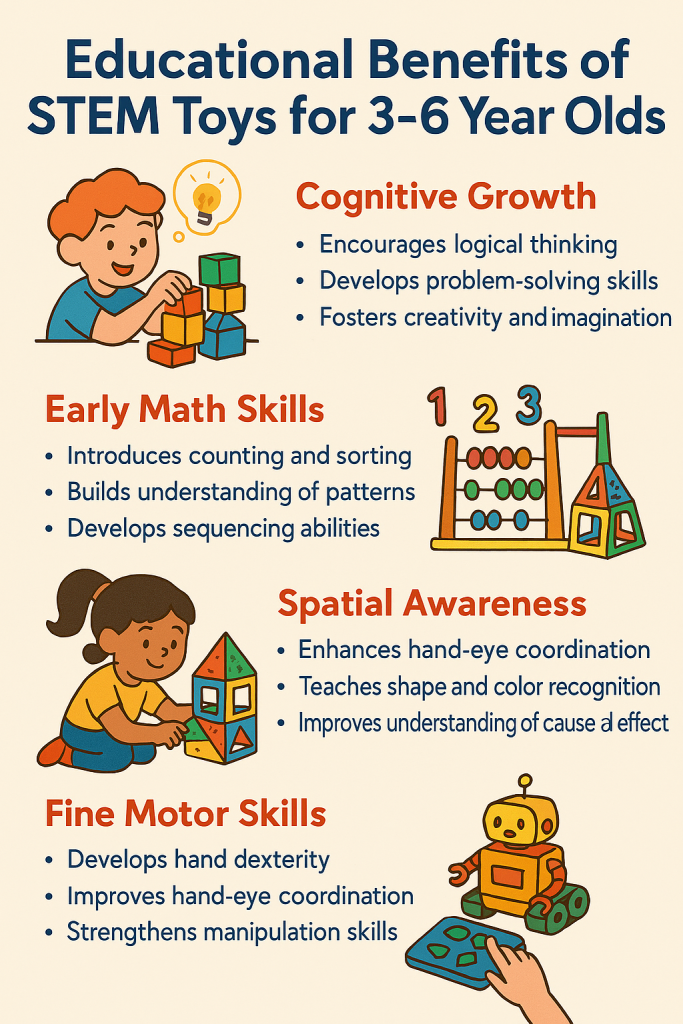Educational Benefits of STEM Toys
Watching a tiny engineer snap together colourful bricks or a budding scientist explore bubbling beakers can feel like pure magic. But these moments of play are more than adorable—they’re the first sparks of lifelong learning. STEM toys—those that nurture science, technology, engineering, and math skills—transform playtime into a launchpad for creativity, curiosity, and confidence. Let’s dive into why toys for ages 3 to 6 matter so much, which skills they build, and how you can amplify your child’s exploration with the perfect toolkit. Do not underestimate the Educational Benefits of STEM Toys
1. Why Play Equals Powerful Brain Building
Every giggle, obstacle overcome, and triumphant “Ta-da!” rewires a young brain:
- Cognitive Growth
When kids sort shapes, count blocks, or test which boat floats, they’re learning cause and effect. The nurturing of logical thinking sets the stage for fluency in math and science later on. - Problem-Solving Confidence
Facing a toppled tower or a puzzle cube that won’t turn? Each challenge encourages persistence, brainstorming solutions, and celebrating successes—critical habits for engineers and inventors. - Creativity and Imagination
STEM toys aren’t rigid recipes; they’re open-ended canvases. A simple set of gears can become a spinning carousel, a racing car, or an alien spaceship, letting children sculpt their own stories and develop divergent thinking.

2. Core STEM Skills in Every Toy Box
Building a solid foundation between ages 3 and 6 unlocks a lifetime of exploration. Here’s what your child could be learning:
- Early Math Skills
Counting beads, sorting counters by color or size, and matching patterns nurture number sense and sequencing. - Spatial Awareness
Manipulating blocks, connecting snap-together parts, and rotating puzzle pieces strengthen hand-eye coordination and 3D reasoning. - Cause & Effect
Dropping balls through tubes, stacking rings to topple or balance them, and conducting simple experiments teach basic physics and scientific observation. - Fine Motor Precision
Grasping tiny components, twisting, snapping, and pouring build dexterity and the tiny-muscle control needed for writing, painting, and even coding on tablets.
3. Spotlight on Top STEM Toys for 3–6 Year Olds
- Magnetic Building Tiles
Vibrant, translucent squares and triangles click together to form walls, bridges, or abstract sculptures. They teach geometry basics, balance, and creative design. Magnetic Tiles. - Simple Coding Robots
Programmable bugs or rovers with chunky “forward,” “turn,” and “beep” buttons introduce sequencing and algorithmic thinking without screens. - Science Discovery Kits
Kits with magnifying glasses, funnels, test tubes, and nature-themed cards turn a backyard stroll into a scientific expedition. - Gear and Pulley Sets
Kids learn mechanical advantage by cranking handles to spin gears or lift small weights—instilling foundational engineering concepts. - Pattern-Matching Puzzles
From lacing cards to shape-sorting boards, these puzzles reinforce pattern recognition, early math skills, and fine motor control.
4. Tips for Maximizing Playtime Learning
- Follow Their Lead
Let your child choose the toy and set the pace. Their curiosity naturally guides them toward challenges they’re ready to conquer. - Ask Open-Ended Questions
“What happens if we build it taller?” or “How could you make that car go faster?” prompts critical thinking and experimentation. - Celebrate “Happy Failures”
When a bridge collapses or a sequence doesn’t work, call it a win—each “failure” teaches what not to do next time. - Mix and Match Materials
Combine blocks with natural items (stones, sticks) or art supplies (glitter, paint). Cross-disciplinary play blends science, engineering, and art. - Document Their Creations
Snap photos or make a “Discovery Board.” Reflecting on past builds helps kids notice progress and fuels their excitement to try new ideas.
5. Beyond the Toy Box: Building a STEM Mindset
STEM learning isn’t just about specialized toys—it’s a lens through which children explore the world. Encourage them to:
- Observe natural phenomena (rainbows, plant growth) and ask “Why?”
- Help you in simple DIY projects (measuring, mixing paint).
- Engage in family science time—baking, gardening, or stargazing together.
By weaving STEM thinking into daily life, you show that experimentation and discovery aren’t confined to playroom shelves—they’re everywhere.
Ready, Set, Explore!
Every stack of blocks, every magnetic snap, and every code-commanded robot step is a thrilling stride toward confidence, creativity, and critical thinking. When you invite STEM toys into your 3–6-year-olds’ world, you’re giving them more than playtime—you’re equipping tomorrow’s innovators with curiosity, resilience, and the joy of discovery. The Educational Benefits of STEM toys are far-reaching and will help your child on their learning journey.